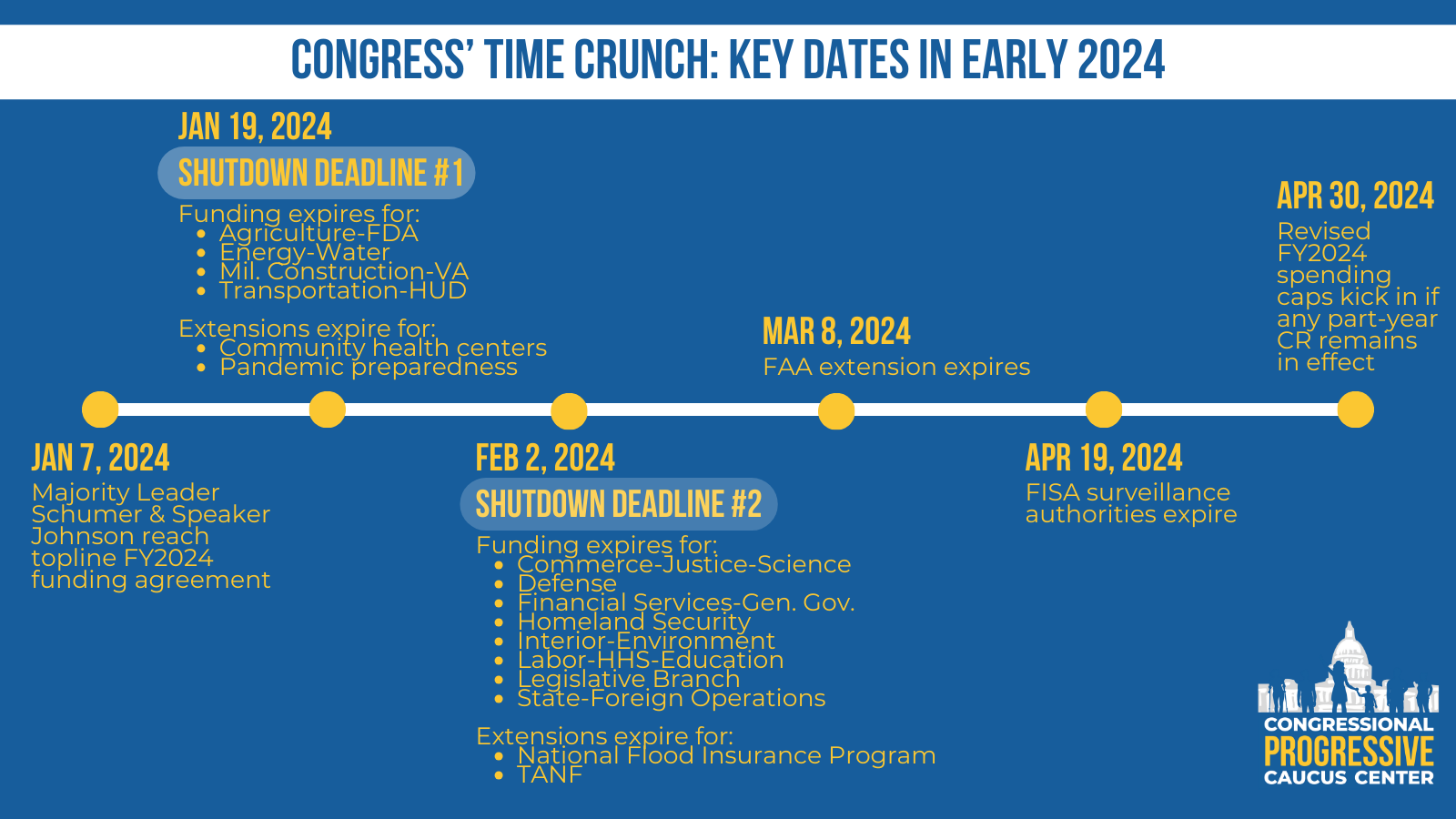January 19, 2024: What questions must Congress answer before March 1?
Yesterday, Congress approved a short-term funding bill to keep the government open for six weeks. We lay out the looming tight timelines and tough questions facing Congress below.
The CPC Center just launched a sign-up portal to expand access to these Unrig the Rules updates! If you were forwarded this email and wish to receive future updates, please register here. Feel free to share this link with anyone in your network.
New Dates to Know
The newly-passed continuing resolution (CR) funds parts of the government through March 1 and the rest through March 8. The latter coincides with the deadline for Congress to extend other critical programs, including the Federal Aviation Administration (FAA) and community health centers. Government spying authorities under the Foreign Intelligence Surveillance Act (FISA) expire just over a month later on April 19.
Additionally, there will be intense pressure to pass an appropriations package that covers the rest of Fiscal Year (FY) 2024 (through September 30) and avoid another short-term funding patch. Under last year’s Fiscal Responsibility Act (FRA), if any part-year CR remains in effect past April 30, revised FY2024 spending caps will kick in. For a deeper dive into this deadline and its implications, see our December 12 update.
Our timeline lays out these key dates:
What questions must Congress answer before March 1?
Congress has six weeks to work through numerous issues to get a full-year funding agreement approved. Those include:
How much funding will each appropriations bill provide? Earlier this month, Senate Majority Leader Schumer and House Speaker Johnson agreed to topline government funding for FY2024—i.e., how much Congress will allocate for defense and nondefense items (see our January 8 update for more). Unresolved is how to split that money among the 12 appropriations bills. The House and Senate have proposed allocations for each bill that are tens of billions of dollars apart.
How large will earmarks be and what will they cover? Community project funding (a.k.a. earmarks) brings federal money to projects in Members’ districts. Republicans established new rules when they took control of the House last year, capping earmark spending at 0.5 percent of total discretionary spending. The Senate’s cap is 1 percent. The House also banned earmarks from the Defense, Financial Services and Labor-HHS-Education appropriations bills. Projects that previously received funding through these bills include upgrades to hospital equipment, suicide prevention programs, improvements to Indian Health Facilities, and home-based care for older adults. Lawmakers must decide which chambers’ rules to stick with and how much and what earmarks will cover.
What fate awaits policy riders? Speaker Johnson promised Republicans he’d fight for far-right policy riders concerning abortion, LGBTQIA protections, gun violence prevention, and much more. The proposals are nonstarters with House and Senate Democrats, the White House, and even some Republicans. These riders’ fates will impact who will support the final bill.
Where does the supplemental stand? President Biden has asked Congress for two emergency funding packages: $106 billion for Ukraine, Israel, Taiwan, the U.S. border, and other “national security” needs, and $56 billion for domestic disaster aid, child care, broadband, and more. Leaders Schumer and McConnell suggest the Senate could vote as soon as next week on a deal pairing the national security request and immigration policy changes—which, reports indicate, would dismantle the asylum system and increase deportations. However, negotiators have not announced any agreement. Furthermore, Speaker Johnson called the rumored policy changes “dead in the House,” where the far-right is urging the Speaker to insist on extreme immigration policies in exchange for keeping the government open at all. Depending on where talks stand six weeks from now, Members could seek to move one or both of these supplemental requests as part of an FY2024 package.
Will other priorities hitch a ride? Government funding will run out in March just as it’s time for Congress to tackle other issues, like renewing the FAA’s authority. Lawmakers may try to slip necessary extensions into the FY2024 funding bill.
As always, please feel free to reach out if you have any questions or feedback. We’ll continue to keep you updated as the March deadlines approach.


